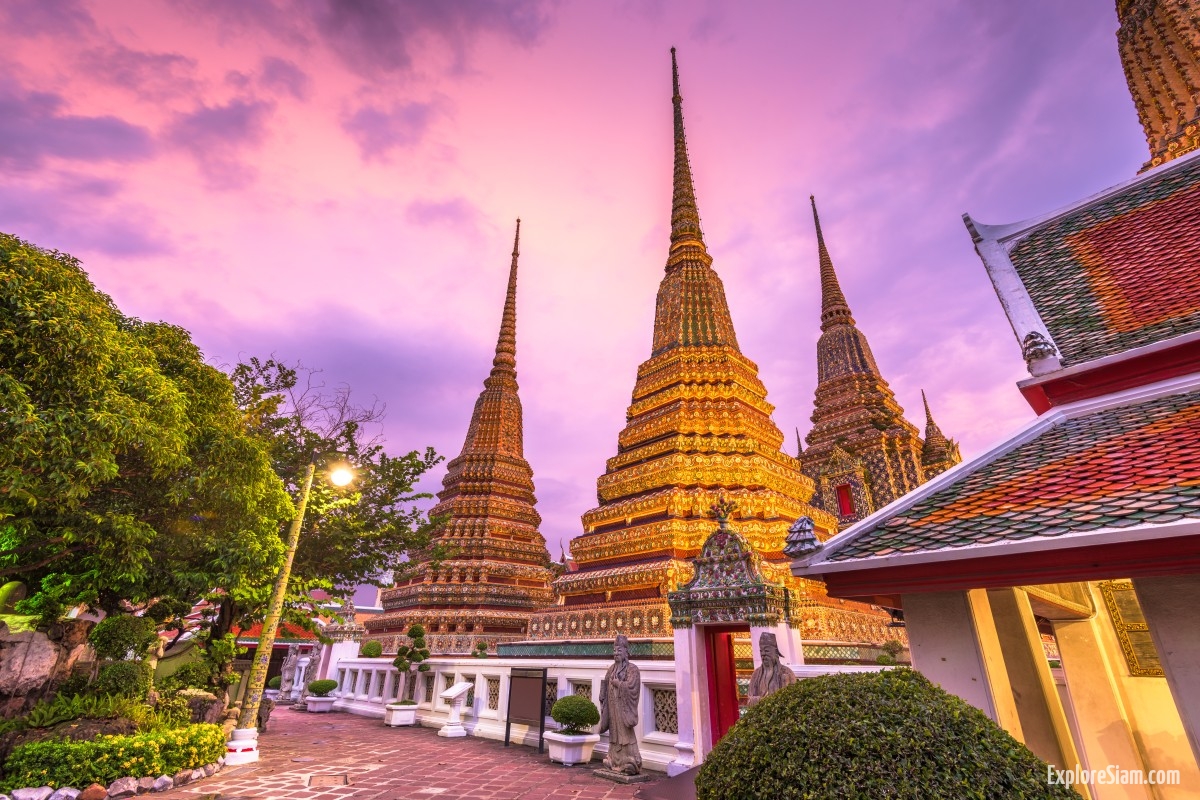Wat Pho, also known as Wat Phra Chetuphon, stands as one of Bangkok’s most iconic and culturally significant temples. Located in the heart of the city, this temple is not only a place of worship but also a historical and educational center that has played a pivotal role in Thai culture for centuries. Its official name is Wat Phra Chetuphon Wimon Mangkhalaram Rajwaramahawihan, which reflects its importance and grandeur.
The temple is renowned for housing the enormous Reclining Buddha statue, one of the largest in Thailand. This magnificent statue measures 46 meters in length and 15 meters in height, making it an awe-inspiring sight. The Reclining Buddha is covered in gold leaf and depicts the Buddha in a serene, resting pose, symbolizing his entry into Nirvana. The soles of the Buddha’s feet are intricately decorated with mother-of-pearl inlay, showcasing 108 auspicious symbols.
Wat Pho is not just about the Reclining Buddha; it is a vast complex that offers visitors a glimpse into the rich history and culture of Thailand. The temple grounds are home to more than 1,000 Buddha images, making it one of the largest collections in the country. These images are housed in various chapels and pavilions, each with its own unique architectural and artistic features. The walls of the temple buildings are adorned with detailed murals depicting scenes from Buddhist mythology and daily life in ancient Thailand.

One of the lesser-known but equally important aspects of Wat Pho is its status as a center of traditional Thai medicine and massage. Wat Pho is considered the birthplace of Thai massage, and the temple complex includes a massage school that has been operating for centuries. Visitors can experience traditional Thai massage performed by skilled practitioners, or even take a course to learn the techniques themselves. The temple’s focus on healing and wellness is a reflection of the holistic approach to health that is deeply rooted in Thai culture.
The history of Wat Pho dates back to the 16th century during the reign of King Rama I, who established the temple on the site of an older temple from the Ayutthaya period. It was significantly expanded and renovated by King Rama III in the 19th century, which included the construction of the Reclining Buddha and the addition of numerous other structures. The temple complex covers an area of 80,000 square meters, making it one of the largest temple complexes in Bangkok.
Architecturally, Wat Pho is a masterpiece of Thai design. The complex features four large stupas dedicated to the first four Chakri kings, with each stupa standing at a height of 42 meters and decorated with colorful mosaics. The main chapel, or Ubosot, houses a golden seated Buddha and is surrounded by a cloister containing hundreds of Buddha images. The temple’s courtyards are filled with lush gardens, statues, and stone inscriptions that provide a peaceful and reflective atmosphere.
Wat Pho’s educational significance is also notable. In addition to its role in preserving traditional Thai medicine and massage, the temple is home to a collection of stone inscriptions that are recognized by UNESCO as part of the Memory of the World Program. These inscriptions include texts on various subjects such as literature, history, medicine, and astrology, highlighting the temple’s role as an educational institution.
Visitors to Wat Pho can immerse themselves in the spiritual and cultural richness of Thailand. The temple is an active place of worship, and visitors are encouraged to participate in traditional ceremonies and offerings. The peaceful ambiance, combined with the stunning architecture and art, provides a serene escape from the bustling city outside.
In conclusion, Wat Pho is much more than a tourist attraction; it is a living testament to Thailand’s religious, cultural, and historical heritage. Its combination of majestic architecture, spiritual significance, and dedication to traditional Thai medicine and education make it a must-visit destination for anyone seeking to understand the essence of Thai culture. Whether you are marveling at the Reclining Buddha, exploring the intricate murals, or experiencing a traditional Thai massage, Wat Pho offers a unique and enriching experience that leaves a lasting impression on all who visit.
Website: www.watpho.com





